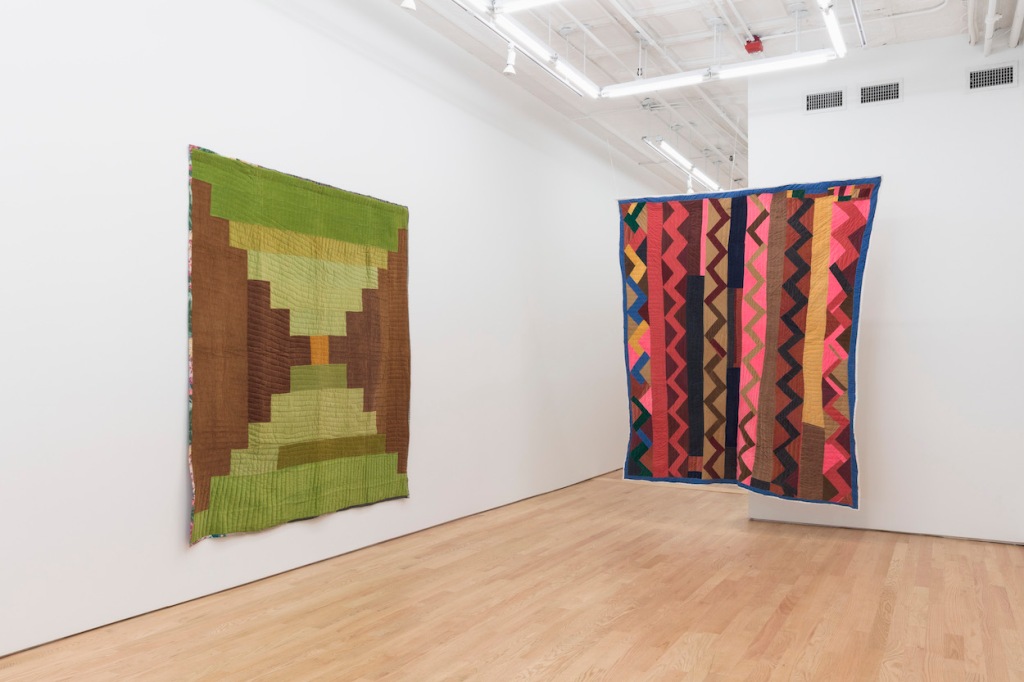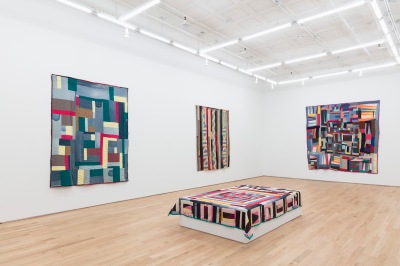 View of “Piece of Mind,” 2021, at Nicelle Beauchene Gallery, showing Bricklayer, 1979-80, and Zig Zag, 2003. Courtesy Nicelle Beauchene Gallery
View of “Piece of Mind,” 2021, at Nicelle Beauchene Gallery, showing Bricklayer, 1979-80, and Zig Zag, 2003. Courtesy Nicelle Beauchene Gallery
In the kaleidoscopic patterns of the eleven quilts on display in Mary Lee Bendolph’s exhibition “Piece of Mind” at Nicelle Beauchene Gallery, each stitch, swatch, and geometric configuration feels as important as the larger work of which it is a part. Bendolph hails from Gee’s Bend, Alabama, and she inherited the piecework quilt-making techniques and visual styles that generations of Black women developed and passed down in that hamlet on a peninsula. Bendolph and other Gee’s Bend quiltmakers’ mastery of abstraction in their work has catapulted what was once a homegrown practice to an internationally acclaimed art form recognized in scholarship, exhibitions, and documentaries. But more often than not, these artists are cast as a collective entity; “Piece of Mind” offers the opportunity to focus on an individual Gee’s Bend creator.
This small selection of works highlights Bendolph’s unique experiments in the medium in the early 2000s while also offering a portal to the American South, specifically to the people and places that form the backdrop of Bendolph’s practice. The show opens with an earlier piece, Bricklayer (1979–80), which provides a glimpse of that wider tradition Bendolph comes from. The work’s title is the local name of a common quilting pattern, typically featuring stacks of scrap fabric increasing in length and width from the center of the quilt outward. In Bendolph’s take, green and brown corduroy fabrics form vertical and horizontal mirrored pyramids that meet in the quilt’s center at a golden square. Optically, the brown stacks seem to recede into the quilt, pushing the green forward and giving the work a sense of depth. Bendolph achieves this multidimensional effect throughout the works on view, which become more haptic as they lie in waves against the flat wall, or flutter with the slight movement of air. That dynamism also extends to the show’s installation: Zig Zag (2003) serves as a floating barrier between the entry gallery and the rest of the exhibition, while A Quilt in a Quilt (2010) is spread out across a low pedestal, as if draped across a bed.
Bendolph’s practice, like those of the other Gee’s Bend quiltmakers, was shaped by intergenerational hardships brought on by the legacy of slavery, economic inequality, and intentional isolation on the part of white residents in the nearby community of Camden during the Jim Crow era. Quilts were once a necessary and precious household item that provided sharecroppers warmth and were thus a means of self-reliance, a result of the community turning inward. But these conditions also facilitated a visual vocabulary and material culture specific to the region.
 View of “Piece of Mind,” 2021, at Nicelle Beauchene Gallery, showing Ghost Pockets, 2003; A Quilt in a Quilt, 2010; KKII, Celebrating You, 2009; and Grandpa Strips, 2010. Courtesy Nicelle Beauchene Gallery
View of “Piece of Mind,” 2021, at Nicelle Beauchene Gallery, showing Ghost Pockets, 2003; A Quilt in a Quilt, 2010; KKII, Celebrating You, 2009; and Grandpa Strips, 2010. Courtesy Nicelle Beauchene Gallery
Following in this lineage, Bendolph’s works are immediately enticing with their rich colors and intricate compositions, yet they also contain a more slowly unfolding material index. Ghost Pockets (2003) refers to the effect of sun bleaching on the included denim strips, where the faded indigo delineates the former presence of pockets. The title also evokes the source of the fabric, the garments of her late husband, and perhaps even the objects that once lined his pockets. In a similar manner, Grandpa Strips (2010) features assorted textures and printed fabrics from Bendolph’s grandchildren’s clothing in a variation on another local pattern of nested squares known as “housetop.” Each textile represents a tradition, a place, and a family, all in one dazzling arrangement.
Amid so much attention on individual style, vision, and technique in the jostling contemporary art world, “Piece of Mind” celebrates a single artist who threads into her work subtle acknowledgments of the people and collective tradition from which it derives. The need for physical warmth and comfort from which the quilts of Gee’s Bend first developed has been reconfigured, in Bendolph’s work, into a desire to represent the importance of one’s home and community.
Source link : https://www.artnews.com/art-in-america/aia-reviews/gees-bend-quilter-mary-lee-bendolph-nicelle-beauchene-1234604675












